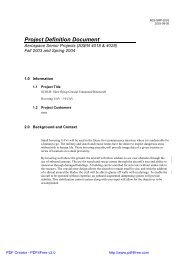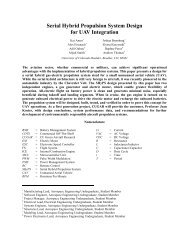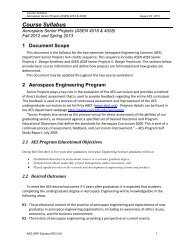PFR - Aerospace Engineering Sciences Senior Design Projects ...
PFR - Aerospace Engineering Sciences Senior Design Projects ...
PFR - Aerospace Engineering Sciences Senior Design Projects ...
You also want an ePaper? Increase the reach of your titles
YUMPU automatically turns print PDFs into web optimized ePapers that Google loves.
Project Final Report – CUDBF April 30 th , 2009<br />
ASEN 4028: <strong>Aerospace</strong> <strong>Senior</strong> <strong>Projects</strong><br />
Figure 89: Wing Geometry Determination Flow Diagram<br />
The stability derivatives calculated from AVL were then used to determine the dimensional<br />
stability of the aircraft under different loading conditions for the chosen geometry. MATLAB<br />
code was created to convert the non-dimensional derivatives provided by AVL into dimensional<br />
derivatives. These were then entered into Equation 15 and Equation 16 along with the inertias<br />
from SolidWorks for each loading case and mission. The eigenvalues of the system were then<br />
plotted to determine the stability of the spiral divergence, dutch-roll, and roll subsidence in the<br />
lateral direction, along with short and long period in the longitudinal direction. The flow<br />
diagram is seen in Figure 90.<br />
Figure 90: Stability Determination Flow Diagram<br />
Finally, drag analysis was needed to establish that the propulsion subsystem provides enough<br />
thrust for the aircraft to perform as expected. The geometry of the aircraft developed in AVL<br />
was created as a three-dimensional model in SolidWorks. The model was then subjected to<br />
Powerflow, and the drag on the body determined.<br />
Figure 91: Drag Calculation Flow Diagram<br />
10.2 Avionics Microcontroller Software<br />
The following explains the software that was programmed to the microcontroller. All coding<br />
was written in C and MPLAB was used to compile the code and generate a hex file, so it could<br />
be programmed to the circuit board via a USB cable.<br />
The microcontroller was programmed such that the pilot had to arm the microcontroller when he<br />
was ready to release the payload. To activate the microcontroller, the pilot simply flipped a<br />
switch on the transmitter. The switch on the transmitter produced two different PWM signals<br />
each with a period of 20.0 ms. One position of the switch produced a signal with a 10% duty<br />
cycle and the other position produced a signal with a 5% duty cycle. The signal was read into the<br />
microcontroller and based on the duty cycle, the microcontroller either did nothing (no<br />
deployment required) or allowed signals to be sent to the payload servos (when deployment was<br />
required). The logic for arming the PIC can be seen in Figure 92. The microcontroller was able<br />
to differentiate between the duty cycles by using the capture module associated with the CCP<br />
pin. In software, it was written such that a flag was set when the CCP pin read a rising edge of<br />
the signal. After setting a flag, a timer was initiated. Once the microcontroller found the falling<br />
113
















